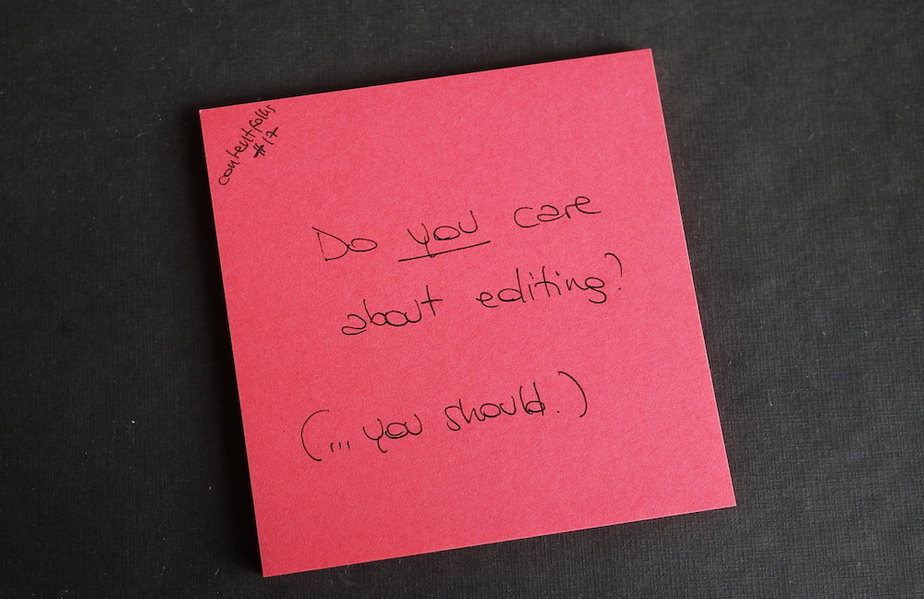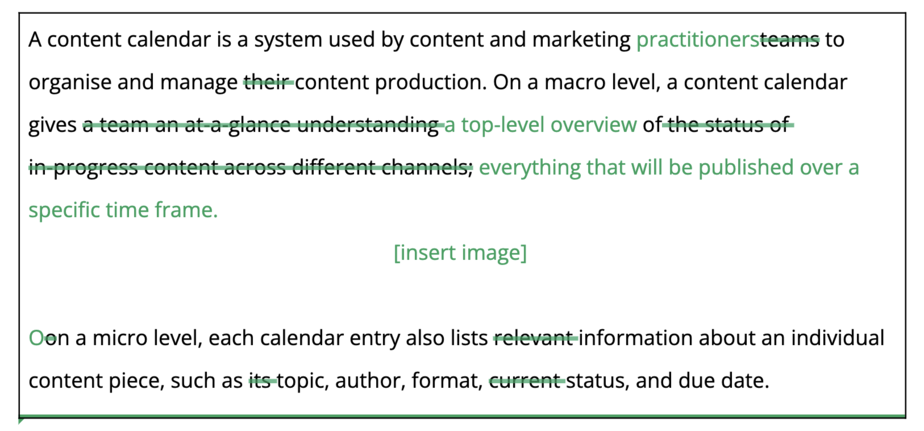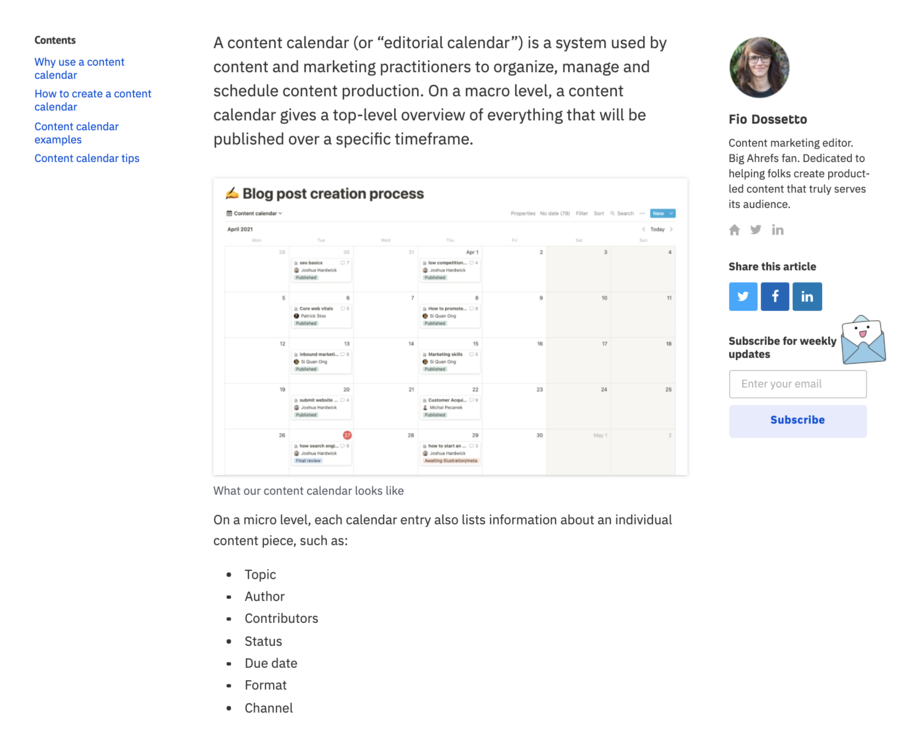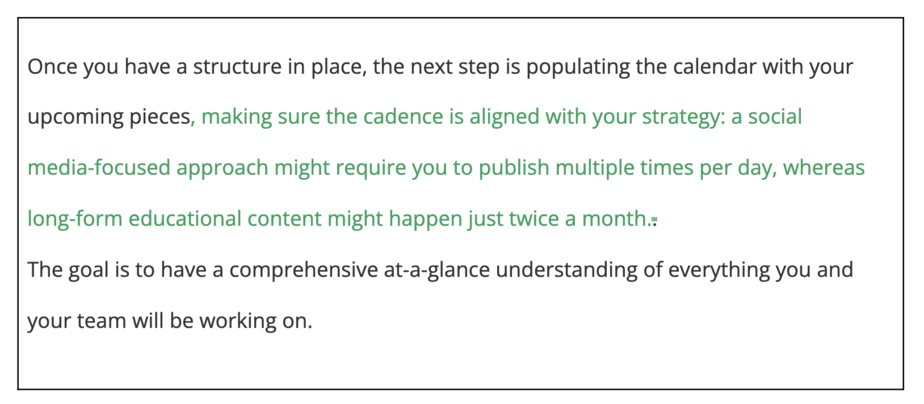
Welcome to contentfolks—a fortnightly newsletter with short lessons & ideas about content that makes a difference, sparks action, and truly serves its audience. Thank you for being here!
Hello hello 👋
Today is the final piece in a four-part series that explores the hidden work behind publishing a blog post. So far, we looked at researching and building a brief, creating an outline, and writing the first draft. Now it’s time for the last step: editing.

To say this is my favourite part of the process is an understatement: editing is one of my favourite things, period. It almost deserves a love poem.
Actually…
✨ An ode to editing ✨
When the first draft is done, it’s time to edit
(Which doesn’t just mean ‘fix the spelling mistakes’)
It’s a process that often doesn’t get credit
So allow me to show you just what it takes
The first stage of edits is called “developmental”
It’s a big-picture look at the story you wrote
It should never be skipped: it’s quite fundamental
To make sure all your points hit the right note
Next are “line edits,” which sharpen the style
Of the sentences, paragraphs, and words you chose
Just so you know—this will take a while;
When it’s done you end up with really tight prose
Then it’s time for a last “copy editing” round
Where you’re looking for typos or odd punctuation
After fixing all glitches and errors you’ve found
Your piece is now ready for publication
From firming the narrative to thorough re-phrasing
Editing is what makes decent content amazing.
Why YOU should care about editing
Editing is often associated with fixing typos 30 minutes before a piece goes live, which is the equivalent of repainting a couple of bricks while the walls are about to cave in: not a great use of everybody’s time.
Discerning users and customers are always looking for reasons to trust a brand. The occasional typo will erode trust, sure, but it’s usually weak, inaccurate, poorly worded, and/or unhelpful content that does the most damage. Which is what editing is ultimately there for:
If you’re a content writer, editing helps you refine your words into clear, impactful, and trustworthy content
- If you’re a content publisher, editing helps you make every piece work for its intended audience and your business.
💡 A practical example 💡
Back to the blog post I’ve been using as an example throughout this series: a piece about content calendars I wrote and edited for Ahrefs.
As an editor, when editing a draft (mine or someone else’s) my goal is to achieve a tightly written & deeply considered piece where:
- All concepts are clearly and succinctly explained
- Sentences, paragraphs, and sections flow smoothly into each other
- Each sentence has been refined and compressed
- There are no typos or grammar mistakes
Take this definition of content calendars:

There aren’t any typos, but the job is far from done. With an editor’s hat on, you might notice:
- Repetition of “teams” and “team” (lines 1 and 2)
- The emphasis on teams excludes any reader who isn’t part of one (e.g. freelancers or solopreneurs)
- “An at-a-glance understanding of the status of in-progress content across different channels” (line 3) is a convoluted description
- Redundant words: “their” (line 2), “relevant” (line 4), “its” and “current” (line 5)
- An image would help make the point clearer
This is what my edits looked like:

And here is the published version. During the final review, we added “editorial calendar” in parentheses to account for the keyword and turned the second half of the definition into an easy-to-read bullet point list:

More examples of things to look out for:
- Repetitions are insidious: you need to be laser-focused to spot them. Here was a blink-and-you-miss-it repetition of “list” (noun) and “lists” (verb); I tweaked the whole sentence to avoid it:

- 85% of the time, the word ‘that’ is unnecessary. Removing it makes writing stronger. When I edit, I call it ‘THAT tax’, as if I had to pay a £10 tax whenever I add an unnecessary ‘that’. Case in point:

- Editing is often about simplifying convoluted phrasing and finding succinct, clearer ways of saying the same thing:

- First drafts are usually filled with redundant, unclear, or tentative sentences. Good editing will ditch whole sections if they don’t add much to the larger point.

- Editing is not just about removing: it’s also about adding. Looking at a piece of writing from the reader’s point of view, an editor might see conceptual gaps that need filling and/or transitions that need adding to stitch different paragraphs together:

- And speaking of looking at things from an audience’s perspective, my first title was quite impersonal while the edited version addresses the reader directly:

I could give you hundreds of examples, because I came in like a wrecking ball and practically dismantled half of the draft I had previously written 😉
And every green correction felt like a step closer to something clear, useful, and impactful for your readers. But if you want to do it properly, there are no shortcuts: in my case, editing the first draft took longer than writing it in the first place.

Here’s how the story ends:
I sent my edited draft to Ahrefs for review, made a few additional tweaks, and the piece went live a few weeks later. You can now read it on the Ahrefs blog!

I hope the last four issues gave you a good idea of what happens behind the scenes of a published content piece: IT’S. A. LOT. OF. WORK, most of which is exciting, some of which is not (I’m looking at you, first draft), all of which is very rewarding if you’ve done it properly and with your audience in mind.
The next time a client asks you to ‘just’ write them another blog post or a manager decides you must publish twice as much in half the time, send them this write-up 😉
